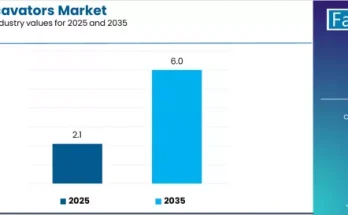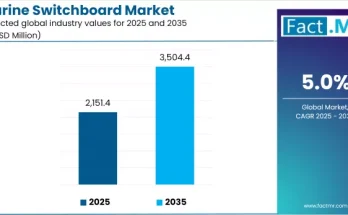The global marine sensors market is projected to expand from USD 37.7 billion in 2025 to approximately USD 59.5 billion by 2035, reflecting a compound annual growth rate (CAGR) of about 4.7% over the forecast period. Growth is driven by escalating demand for advanced sensor solutions across commercial shipping, offshore energy, autonomous underwater vehicles, and defence platforms, with an increasing focus on flow/level/pressure sensors, imaging/sonar systems, and integrated navigation/automation modules.
As marine operations become more complex and data-driven-from vessel navigation and automation to subsea monitoring and environmental sensing-sensor technologies are shifting from auxiliary instruments to core enablers of efficiency, safety, and compliance across maritime ecosystems.
➤Key Market Insights at a Glance
Market Value (2025): USD 37.7 billion
Forecast Value (2035): USD 59.5 billion
CAGR (2025-2035): ~4.7%
Leading Sensor Type: Flow/Level/Pressure Sensors (~46 % share)
Dominant Platform Segment: Shipboard Navigation & Automation (~43 % share)
Key Growth Regions: North America, Europe, Asia-Pacific
Top Players: Kongsberg Maritime; Teledyne Marine; Thales Group; Furuno Electric; Garmin
To Access the Complete Data Tables & in-depth Insights, Request a Discount on this report: https://www.factmr.com/connectus/sample?flag=S&rep_id=3624
➤Market Drivers / Growth Overview
Key factors underpinning the marine sensors market include:
Maritime automation & vessel digitalisation: Increased deployment of sensors for navigation, automation, and monitoring in commercial shipping and offshore operations.
Offshore energy & subsea infrastructure growth: Rising requirements for robust monitoring in oil & gas, wind farms, and underwater assets.
Regulatory, environmental & safety mandates: Marine sensor systems assist compliance with emissions, ballast-water treatment, hull condition monitoring, and navigation-safety requirements.
Growth in research, defence & autonomous systems: Expansion of AUV/ROV platforms, defence maritime programs, and ocean-monitoring systems.
Technological advances and cost declines: Improvements in miniaturisation, data transmission, and ruggedisation enhance performance and accessibility.
The market is tempered by challenges such as corrosion resistance, high initial investment, and complexity of integration across diverse maritime platforms.
➤Segmentation & Key Drivers
By Sensor Type:
Flow/Level/Pressure Sensors lead (~46 % share) due to utility in fluid, fuel, ballast, and vessel-system monitoring.
Acoustic/Sonar & Imaging Sensors account for ~28 % share, driven by demand for underwater detection and imaging.
Environmental/Chemistry Sensors are expanding with marine-ecosystem monitoring applications.
By Platform:
Shipboard Navigation & Automation (~43 % share) dominates due to rising digitalisation of commercial vessels.
Offshore Energy & Subsea Monitoring (~31 % share) benefits from offshore expansion and energy-infrastructure monitoring.
Research / AUV / ROV (~26 % share) represents a growing, technology-intensive niche.
By End-User:
Commercial Shipping & Offshore lead adoption, followed by Defence & Security, and Research & Fisheries.
Segmentation drivers include robustness, platform integration needs, and regional marine-industry maturity.
➤Regional & Country Insights
North America: Exhibits strong growth (U.S. ~5.2% CAGR) due to maritime modernisation and offshore-energy investment.
Europe: Expanding at ~4.2% CAGR, supported by shipping-fleet upgrades, environmental regulation, and sensor standardisation in Germany, France, and the UK.
Asia-Pacific: The fastest-growing region, driven by large commercial-shipping expansion, offshore-energy projects, and sensor adoption.
Latin America / Middle East & Africa: Smaller but rising investment in offshore resources and maritime infrastructure presents incremental opportunities.
Regional performance reflects fleet size, shipbuilding activity, offshore-expansion trends, and regulatory regimes.
➤Competitive Landscape
The marine sensors market is moderately consolidated, with major players holding significant shares. Leading companies include Kongsberg Maritime, Teledyne Marine, Thales Group, Furuno Electric, Garmin, Honeywell, Curtiss-Wright, Sonardyne, Raytheon/RTX, and BAE Systems.
➤Key strategies include:
Offering ruggedised, marine-grade sensors designed for harsh maritime environments.
Expanding system-integration capabilities combining sensors, platforms, and software.
Investing in after-sales service, calibration, and lifecycle support to enhance uptime.
Extending presence in emerging markets through partnerships and regional service networks.
Developing environmental and subsea sensors for offshore energy and ocean-monitoring applications.
➤Market Outlook & Strategic Insights
Through 2035, the marine sensors market is expected to evolve toward higher-precision, networked, and integrated sensor ecosystems. Strategic priorities for market participants include:
Prioritising flow/level/pressure systems with stable, large-scale demand.
Investing in subsea, sonar, and environmental sensors for offshore energy applications.
Focusing on Asia-Pacific as a key growth hub.
Enhancing service and lifecycle-support capabilities to build recurring revenue.
Tracking emerging regulations and standardisation trends influencing marine-sensor specifications.
Companies that combine reliability, marine-grade design, and global support networks will be best positioned to capture growth in a market projected to reach nearly USD 59.5 billion by 2035.
➤Browse Full Report: https://www.factmr.com/report/3624/marine-sensors-market
Have specific requirements or need assistance on report pricing or have a limited budget? Please contact sales@factmr.com
➤About Fact.MR:
Fact.MR is a global market research and consulting firm, trusted by Fortune 500 companies and emerging businesses for reliable insights and strategic intelligence. With a presence across the U.S., UK, India, and Dubai, we deliver data-driven research and tailored consulting solutions across 30+ industries and 1,000+ markets. Backed by deep expertise and advanced analytics, Fact.MR helps organizations uncover opportunities, reduce risks, and make informed decisions for sustainable growth.



